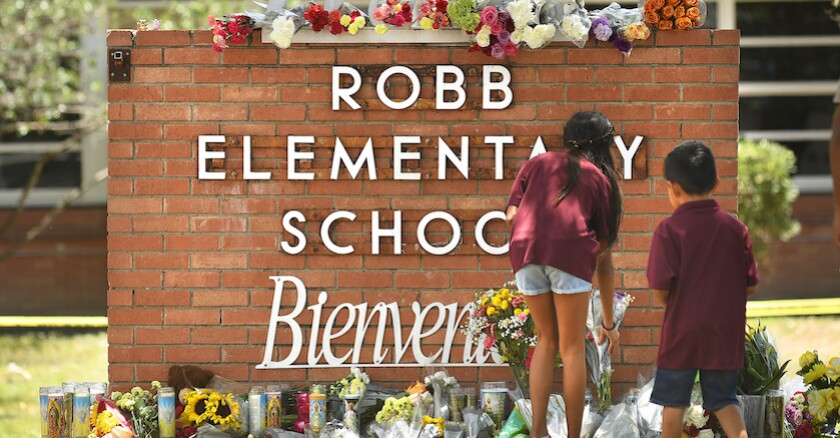“How are we going to continue the important work of academic recovery and mental health supports in response to the pandemic when we can’t reasonably ensure the core need for physical safety?” Domenech said.
“Gun violence is a cancer, and it’s one that none of us should tolerate for one single moment longer,” said Randi Weingarten, president of the American Federation of Teachers (AFT). “We have made a choice to let this continue, and we can make a choice to finally do something — do anything — to put a stop to this madness.”
AFT collaborated with Everytown for Gun Safety Support Fund and the National Education Association (NEA) to produce “Keeping Our Schools Safe,” a report that outlines a comprehensive plan to end gun violence in American schools. It remains to be seen whether events in Uvalde will spur Congress into action, but the report makes it clear that states can play a much bigger role.
One strategy is the enactment of extreme risk laws, which empower community members to work with courts and remove firearms from persons they feel pose a danger to others. Depending on the provisions in a particular state, a request for an Extreme Risk Protection Order (ERPO) can be initiated by law enforcement, a family or household member, a health professional or even a school administrator. Such laws are currently in place in 19 states and the District of Columbia.
States can also enact and enforce firearm storage laws. A letter published by the American Medical Association that reviewed findings from the 2021 National Firearms Survey reported that about 30 million American children live in households with firearms, 7 million more than in 2015. An estimated 4.6 million live in households with unlocked and loaded firearms.
According to the Giffords Law Center, only 13 states have laws mandating safe storage. Even these have loopholes, with some requiring storage “sometimes,” some applying to handguns only, some vague on the standards for locks. Only two, Massachusetts and Oregon, require all firearms to be stored with a lock in place.
AFT and its partners also urge stricter age requirements for gun purchases and possession, noting that most school shooters have been school-age. “Data show that 18-to-20-year-olds commit gun homicides at a rate four times higher than adults 21,” they say.
“Research shows the 18-20-year-old age group is among the highest risk to commit violence with firearms, yet in most states the ability to purchase these deadly weapons is less restricted than the ability to purchase beer,” said Joshua Horwitz, JD, co-director of the Johns Hopkins Center for Gun Violence Solutions. “This is a clear example of how weaknesses in gun laws continue to pose threats to communities across the country."
Only 10 states limit gun possession to persons 21 and older; just 17 set this standard for handgun purchases.
States can also do much more to ensure that guns stay out of the hands of persons likely to misuse them, those with criminal records, histories of severe mental problems or addiction, or persons subject to restraining orders. At present, only 14 states and the District of Columbia require that purchases of all classes of firearms, whether from a licensed dealer or unlicensed seller, include a background check. This is out of sync with attitudes reported by the Pew Research Center, which found that 93 percent of Democrats and 82 percent of Republicans approve of them.
A strategy that NEA and AFT don’t support is arming school personnel. While this might seem sensible to some gun enthusiasts, law enforcement disagrees. J. Thomas Manger, the chief of the U.S. Capitol Police and a past president of the Major Cities Chiefs Association, has put it this way: “A cop shows up and there’s people with guns in their hand. We don’t know who’s the good guy, who’s the bad guy. That’s very dangerous for the police. And it’s dangerous for the community.”
Gun violence isn’t just a public safety problem. A recent analysis of CDC mortality data found that firearm-related injuries had become the leading cause of death among children and adolescents. As long ago as 2016, the American Medical Association declared gun violence to be a public health crisis “unrivaled in any other developed country.”
Researchers are working to understand which policies work best to reduce firearm risk, says Patrick Carter, co-director of the Institute for Firearm Injury Prevention at the University of Michigan. “We do know that states with more comprehensive policies in place have lower rates of firearm injury outcomes.”
As more states implement policy interventions such as ERPO laws, researchers will have more opportunities to understand how and why they work, Carter says. This will make it possible to develop evidence-based solutions for this complex public health problem.
“How many more students have to walk into a school, only to never walk out?” asks AASA’s Domenech. “Our children have a right to live and learn in a safe environment. If these tragedies do not serve as a serious wake-up call to our nation to take action, I don’t know what will.”
Editor's Note: The map in this article was updated to clarify that some states require an individual to be 21 for a handgun purchases, not all classes of firearms.
Related Articles











